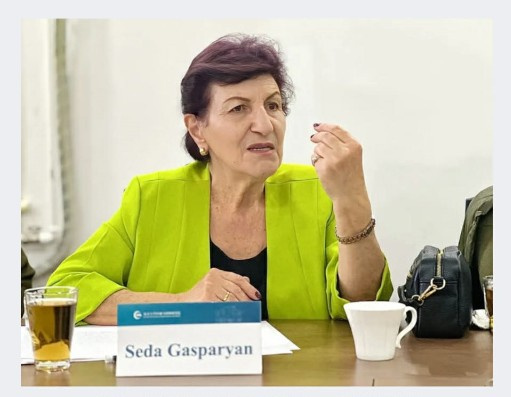Professor Seda Gasparyan from the Chair of English Philology at the YSU Faculty of European Languages and Communication, Corresponding Member of the National Academy of Sciences of Armenia and Honored Figure of Science of the Republic of Armenia, together with Associate Professor Dr. Lusine Sahakyan from the Chair of Turkology at the YSU Faculty of Oriental Studies, participated in an international symposium organized at Lanzhou University, China.
The speakers presented several key findings achieved within the framework of a joint research project conducted by S. Gasparyan, A. Safaryan, and L. Sahakyan, dedicated to Armenian–Kipchak relations and to the grammatical peculiarities of the Kipchak language. The report generated considerable interest and prompted an active discussion.

Beyond the symposium, various meetings were held, during which future opportunities for academic cooperation were discussed.
Scientific interactions and discussions continued at Peking University, where the Armenian scholars had been invited to deliver lectures. On October 16, at the Institute of Regional and International Studies of Peking University, Professor S. Gasparyan delivered a lecture titled "The Role of Armenians in the Public and Cultural Life of the Ottoman Empire". The event was moderated by the institute's Deputy Director, Professor Zhang Tao. The lecture was attended by Associate Professor Dr. Lusine Sahakyan from the YSU Chair of Turkology, as well as professors, researchers, and graduate students from Peking University, all of whom actively engaged in the ensuing discussion.
At the core of the lecture was the invaluable role of Armenians in the political, economic, and cultural life of the Ottoman Empire, their immense contribution to the Empire's financial system, crafts, architecture, and arts, and their fundamental and undeniable impact on the country’s economic and aesthetic landscape. Professor Gasparyan also elaborated on the active participation of Armenian intellectuals in the process of the Tanzimat reforms, emphasizing the crucial contribution Armenians made to the formation, development, and modernization of nearly all spheres of Ottoman public life. During the lecture, Professor Gasparyan highlighted and elucidated the essential fact that Armenians were not only participants in the public and cultural life of the Empire but also engines of innovation and modernization.

It was also emphasized that the history of the Armenian people within the Ottoman Empire is not solely one of tragedy and irreversible loss—culminating in the catastrophic Armenian Genocide perpetrated by the Young Turks between 1915 and 1923—but also a history of creation and cultural achievement. Even the repression, forced migrations, and massacres inflicted upon Armenians could not halt their civilizational mission. Therefore, to study the Ottoman Empire while ignoring the Armenian contribution would be akin to describing a body without its soul.
During the discussion, Professor Zhang Tao and Associate Professor Shi Yuan, analyzing the importance of civilizational research from the perspectives of Oriental studies and postcolonial scholarship, noted that China and Armenia, as bearers of ancient civilizations, must pay particular attention to studies that advance cultural consciousness and should seek new opportunities for multifaceted cooperation.
The participating scholars highly praised the lecture, noting that it not only revealed the distinctive role of Armenians in the multilayered structure of the Ottoman Empire but also offered a new lens for understanding intercivilizational interactions and the academic significance of regional studies. The lecture concluded with prolonged and warm applause.
Further questions concerning future cooperation were also discussed.


